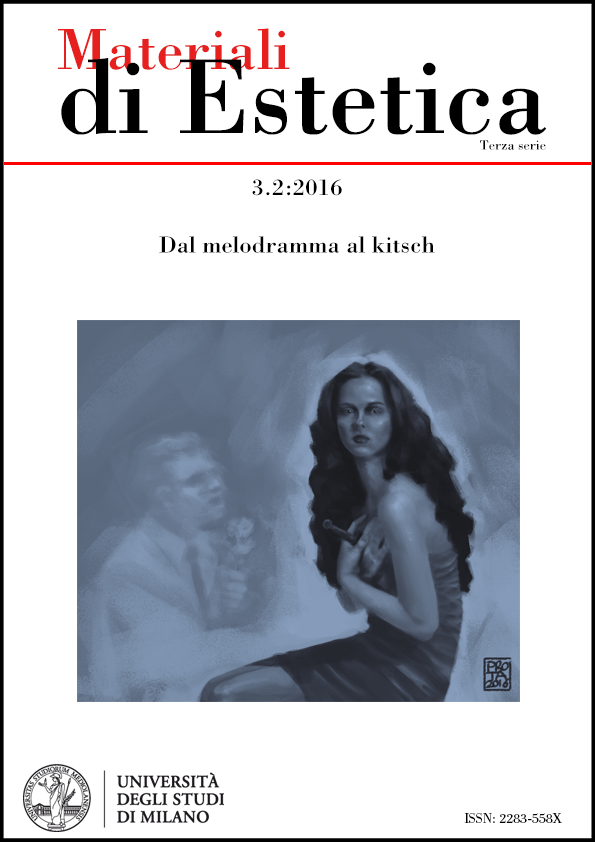Musica melodrammatica e sincronizzazione
DOI:
https://doi.org/10.13130/mde.v0i3.2.8044Abstract
Melodrama – both as a genre and as a mode – has been redefined and reevaluated since the early Seventies by scholars such as Thomas Elsaesser and Peter Brooks. Despite the importance of orchestral accompaniment in theatrical and cinematic melodramas, one which has long been considered evident, melodramatic music has received much less musicological attention than it deserves. My purpose in this article is to present some preliminary reflections on music synchronization for both the melodramatic stage and screen. The close relationship between music and action in melodrama, at times criticized as being tautological and redundant, is not as banal as it might seem. In melodramatic expression, which combines mimetic music with text and/or image, there is no musical intervention without dramaturgical consequences. Even the contrapuntal/anempathetic sound – often utilized as melodramatic effect – is an exception, which confirms the rule of music and drama synchronization.
Riferimenti bibliografici
ANKER, Elisabeth, “Villains, Victims, and Heroes: Melodrama, Media, and September 11”, Journal of Communication, 55, 1 (2005), pp. 22-37.
BERTRAND, Gustave, “Semaine théâtrale”, Le Menéstrel, 6 ottobre 1872.
BROOKS, Peter, L’immaginazione melodrammatica, tr. it. di D. Fink, Pratiche, Parma 1985. [The Melodramatic Imagination. Balzac, Henry James and the Mode of Excess, Yale University Press, New Haven-London 1976].
CHION, Michel, L’audiovision. Son et image au cinéma (1990), Armand Colin, Paris 20122.
ELSAESSER, Thomas, “Tales of Sound and Fury: Observations on the Family Melodrama”, Monogram, 4 (1972), pp. 2-15; tr. it. “Storie di rumore e furore: osservazioni sul melodramma familiare”, in Filmcritica, 339-340 (1983).
GRANT, Barry Keith (a cura di), Film Genre Reader II, University of Texas Press, Austin 1995.
HIBBERD, Sarah, “Introduction”, in Ead. (a cura di), Melodramatic Voices. Understanding Music Drama, Ashgate, Farnham 2011.
JAUBERT, Maurice, “La musique dans le film” (1944), in M. L’Herbier (a cura di), Intelligence du cinématographe, Éditions Corrêa, Paris 1946, pp. 368-371.
MALLARMÉ, Stéphane, “Crayonné au théâtre” (1887), in H. Mondor e G. Jean-Aubry (a cura di), Œuvres complètes, Gallimard, Paris 1945, pp. 296-297.
PEZZOTTA, Alberto (a cura di), Forme del melodramma, Bulzoni, Roma 1992.
PISANI, Michael V., Music for the Melodramatic Theatre in Nineteenth-Century London & New York, University of Iowa Press, Iowa City 2014.
SALA, Emilio, L’opera senza canto. Il mélo e l’invenzione della colonna sonora, Marsilio, Venezia 1995.
–, “In che senso El Dorado di L’Herbier è un mélodrame?”, in E. Dagrada (a cura di), Il Melodramma, Bulzoni, Roma 2007, pp. 111-144.
–, “La ‘mélodie de l’esprit’ dei Frères corses come ‘voce acusmatica’. Musica e effetto dal mélodrame al cinema”, Trans. Revista transcultural de música, 18 (2014) [on line]: http//www.sibetrans.com/trans/publicacion/21/trans-18-2014
SCARAMUZZA, Gabriele, “Il melodramma come categoria estetica”, in P. D’Oriano (a cura di), Per una fenomenologa del melodramma, Quodlibet, Macerata 2006, pp. 113-140.
VALÉRY, Paul, “À propos de Sémiramis” (1934), in J. Hytier (a cura di), Œuvres, 2 voll., Gallimard, Paris 1957-1960, vol. I, pp. 1709-1710.
VEEN, Jan Van der, Le mélodrame musical de Rousseau au Romantisme, M. Nijhoff Publishers, La Haye 1955.
WAEBER, Jacqueline, En musique dans le texte. Le mélodrame, de Rousseau à Schoenberg, Van Dieren, Paris 2005.
ZOLA, Émile, Nos auteurs dramatiques, G. Charpentier, Paris 1881.






